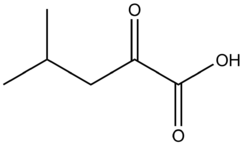
| |
| Names | |
|---|---|
| IUPAC name 4-Methyl-2-oxopentanoic acid | |
| Systematic IUPAC name 4-Methyl-2-oxopentanoic acid | |
| Other names
4-Methyl-2-oxovaleric acid 2-Ketoisocaproic acid 2-Oxo-4-methylpentanoic acid 2-Oxo-4-methylvaleric acid 2-Oxoisocaproic acid 2-Oxoleucine Isobutylglyoxylic acid Ketoleucine α-Ketoisocapronic acid α-Oxoisocaproic acid | |
| Identifiers | |
| CAS Number | |
| 3D model (JSmol) | |
| Beilstein Reference | 1701823 |
| ChEBI | |
| ChEMBL | |
| ChemSpider | |
| DrugBank | |
| ECHA InfoCard | 100.011.304 |
| EC Number |
|
| IUPHAR/BPS | |
| KEGG | |
| MeSH | Alpha-ketoisocaproic+acid |
| PubChem CID | |
| UNII | |
| UN number | 3265 |
| CompTox Dashboard (EPA) | |
InChI
| |
SMILES
| |
| Properties | |
| Chemical formula | C6H10O3 |
| Molar mass | 130.143 g·mol |
| Density | 1.055 g cm (at 20 °C) |
| Melting point | 8 to 10 °C (46 to 50 °F; 281 to 283 K) |
| Boiling point | 85 °C (185 °F; 358 K) at 13 mmHg |
| log P | 0.133 |
| Acidity (pKa) | 2.651 |
| Basicity (pKb) | 11.346 |
| Hazards | |
| GHS labelling: | |
| Pictograms | 
|
| Signal word | Danger |
| Hazard statements | H314 |
| Precautionary statements | P260, P264, P280, P301+P330+P331, P303+P361+P353, P304+P340, P305+P351+P338, P310, P321, P363, P405, P501 |
| Except where otherwise noted, data are given for materials in their standard state (at 25 °C , 100 kPa).
| |
α-Ketoisocaproic acid (α-KIC), also known as 4-methyl-2-oxovaleric acid, and its conjugate base and carboxylate, α-ketoisocaproate, are metabolic intermediates in the metabolic pathway for L-leucine. Leucine is an essential amino acid, and its degradation is critical for many biological duties. α-KIC is produced in one of the first steps of the pathway by branched-chain amino acid aminotransferase by transferring the amine on L-leucine onto alpha ketoglutarate, and replacing that amine with a ketone. The degradation of L-leucine in the muscle to this compound allows for the production of the amino acids alanine and glutamate as well. In the liver, α-KIC can be converted to a vast number of compounds depending on the enzymes and cofactors present, including cholesterol, acetyl-CoA, isovaleryl-CoA, and other biological molecules. Isovaleryl-CoA is the main compound synthesized from ɑ-KIC. α-KIC is a key metabolite present in the urine of people with Maple syrup urine disease, along with other branched-chain amino acids. Derivatives of α-KIC have been studied in humans for their ability to improve physical performance during anaerobic exercise as a supplemental bridge between short-term and long-term exercise supplements. These studies show that α-KIC does not achieve this goal without other ergogenic supplements present as well. α-KIC has also been observed to reduce skeletal muscle damage after eccentrically biased resistance exercises in people who do not usually perform those exercises.
Biological activity
Supplements
α-KIC has been studied as a nutritional supplement to aid in the performance of strenuous physical activity. Studies have shown that taking ɑ-KIC and its derivatives before acute physical activity led to an increase in muscle work by 10%, as well as a decrease in muscle fatigue during the early phase of the physical activity. When taken with other supplements over a two-week period, such as beta-hydroxy beta-methylbutyrate (HMB), participants reported delayed onset of muscle soreness, as well as other positive effects such as increased muscle girth. It is important to note that studies have also suggested that ɑ-KIC taken alone did not have any significant positive impacts on physical performance, so it should be taken in conjunction with other ergogenic substances. ɑ-KIC is not available as a supplement on its own, but its decarboxylated form HMB is available in calcium salt capsules or powder.
Applications
The biochemical implications of α-KIC are largely connected to other biochemical pathways. Protein Synthesis, skeletal muscle regeneration, and skeletal muscle proteolysis have all been noted to change when ɑ-KIC is taken. There is not much research into the specific mechanisms taking part in these processes, but there is a noticeable correlation between ɑ-KIC ingestion and increased skeletal muscle protein synthesis, regeneration, and proteolysis.
Toxicity
Multiple studies have demonstrated that there have been no adverse effects on humans nor animals that ingested α-KIC or HMB.
In patients with maple syrup urine disease, who are unable to metabolize the branched chain alpha keto acids, α-KIC is believed to be one of the key mediators of neurotoxicity.
Medical use
Branched-chain alpha-keto acids such as α-KIC are found in high concentrations in the urine of people who suffer from Maple Syrup Urine Disease. This is disease is caused by a partial branched-chain alpha-keto acid dehydrogenase deficiency, which leads to a buildup of branched-chain alpha-keto acids, including α-KIC and HMB. These keto-acids build up in the liver, and since limited isovaleryl-CoA can be produced, these keto-acids must be excreted in the urine as α-KIC, HMB, and many other similar keto acids. Flare-ups in people who have this condition are caused due to poor diet. Symptoms of Maple Syrup Urine Disease include sweet smelling urine, irritability, lethargy, and in serious cases edema of the brain, apnea, coma, or respiratory failure. Treatment includes lowering leucine intake and a specialized diet to make up for the lack of leucine ingestion.
Leucine metabolism
Leucine metabolism in humans
 L-Leucine
Branched-chain amino
L-Leucine
Branched-chain aminoacid aminotransferase α-Ketoglutarate Glutamate Glutamate Alanine Pyruvate Muscle: α-Ketoisocaproate (α-KIC) Liver: α-Ketoisocaproate (α-KIC) Branched-chain α-ketoacid dehydrogenase (mitochondria) KIC-dioxygenase (cytosol) Isovaleryl-CoA β-Hydroxy β-methylbutyrate (HMB) Excreted in urine (10–40%)
(HMG-CoA) β-Methylcrotonyl-CoA (MC-CoA) β-Methylglutaconyl-CoA (MG-CoA) CO2 CO2 O2 CO2 H2O CO2 H2O (liver) HMG-CoA lyase Enoyl-CoA hydratase Isovaleryl-CoA dehydrogenase MC-CoA carboxylase MG-CoA hydratase HMG-CoA reductase HMG-CoA synthase β-Hydroxybutyrate dehydrogenase Mevalonate pathway Thiolase Unknown enzyme β-Hydroxybutyrate Acetoacetyl-CoA Acetyl-CoA Acetoacetate Mevalonate Cholesterol |
References
- CID 70 from PubChem
- ^ Wilson, Jacob M.; Fitschen, Peter J.; Campbell, Bill; Wilson, Gabriel J.; Zanchi, Nelo; Taylor, Lem; Wilborn, Colin; Kalman, Douglas S.; Stout, Jeffrey R.; Hoffman, Jay R.; Ziegenfuss, Tim N.; Lopez, Hector L.; Kreider, Richard B.; Smith-Ryan, Abbie E.; Antonio, Jose (2 February 2013). "International Society of Sports Nutrition Position Stand: beta-hydroxy-beta-methylbutyrate (HMB)". Journal of the International Society of Sports Nutrition. 10 (1): 6. doi:10.1186/1550-2783-10-6. PMC 3568064. PMID 23374455.
- "Leucine".
- ^ Zanchi, Nelo Eidy; Gerlinger-Romero, Frederico; Guimarães-Ferreira, Lucas; de Siqueira Filho, Mário Alves; Felitti, Vitor; Lira, Fabio Santos; Seelaender, Marília; Lancha, Antonio Herbert (April 2011). "HMB supplementation: clinical and athletic performance-related effects and mechanisms of action". Amino Acids. 40 (4): 1015–1025. doi:10.1007/s00726-010-0678-0. PMID 20607321. S2CID 11120110.
- ^ Kohlmeier, M (May 2015). "Leucine". Nutrient Metabolism: Structures, Functions, and Genes (2nd ed.). Academic Press. pp. 385–388. ISBN 978-0-12-387784-0.
- ^ Strauss, Kevin A; Puffenberger, Erik G; Carson, Vincent J (1993). "Maple Syrup Urine Disease". GeneReviews. University of Washington, Seattle.
- ^ Stevens, Bruce R. (2013). "An Overview of Glycine-Arginine-Alpha-Ketoisocaproic Acid (GAKIC) in Sports Nutrition". Nutrition and Enhanced Sports Performance. pp. 433–438. doi:10.1016/B978-0-12-396454-0.00044-8. ISBN 978-0-12-396454-0.
- ^ Someren, Ken A. van; Edwards, Adam J.; Howatson, Glyn (1 August 2005). "Supplementation with β-Hydroxy- β-Methylbutyrate (HMB) and α-Ketoisocaproic Acid (KIC) Reduces Signs and Symptoms of Exercise-Induced Muscle Damage in Man". International Journal of Sport Nutrition and Exercise Metabolism. 15 (4): 413–424. doi:10.1123/ijsnem.15.4.413. PMID 16286672.
- Yarrow, Joshua F; Parr, Jeffrey J; White, Lesley J; Borsa, Paul A; Stevens, Bruce R (December 2007). "The effects of short-term alpha-ketoisocaproic acid supplementation on exercise performance: a randomized controlled trial". Journal of the International Society of Sports Nutrition. 4 (1): 2. doi:10.1186/1550-2783-4-2. PMC 2042499. PMID 17908285.
- Nissen, S.; Sharp, R. L.; Panton, L.; Vukovich, M.; Trappe, S.; Fuller, J. C. (1 August 2000). "β-Hydroxy-β-Methylbutyrate (HMB) Supplementation in Humans Is Safe and May Decrease Cardiovascular Risk Factors". The Journal of Nutrition. 130 (8): 1937–1945. doi:10.1093/jn/130.8.1937. PMID 10917905.
- Baxter, J.H.; Carlos, J.L.; Thurmond, J.; Rehani, R.N.; Bultman, J.; Frost, D. (December 2005). "Dietary toxicity of calcium β-hydroxy-β-methyl butyrate (CaHMB)". Food and Chemical Toxicology. 43 (12): 1731–1741. doi:10.1016/j.fct.2005.05.016. PMID 16006030.
- Zinnanti, William J.; Lazovic, Jelena (2012). "Interrupting the mechanisms of brain injury in a model of maple syrup urine disease encephalopathy". Journal of Inherited Metabolic Disease. 35 (1): 71–79. doi:10.1007/s10545-011-9333-5. PMID 21541722. S2CID 1253267.
- ^ Strauss, Kevin A.; Wardley, Bridget; Robinson, Donna; Hendrickson, Christine; Rider, Nicholas L.; Puffenberger, Erik G.; Shelmer, Diana; Moser, Ann B.; Morton, D. Holmes (April 2010). "Classical maple syrup urine disease and brain development: Principles of management and formula design". Molecular Genetics and Metabolism. 99 (4): 333–345. doi:10.1016/j.ymgme.2009.12.007. PMC 3671925. PMID 20061171.
- ^ Wilson JM, Fitschen PJ, Campbell B, Wilson GJ, Zanchi N, Taylor L, Wilborn C, Kalman DS, Stout JR, Hoffman JR, Ziegenfuss TN, Lopez HL, Kreider RB, Smith-Ryan AE, Antonio J (February 2013). "International Society of Sports Nutrition Position Stand: beta-hydroxy-beta-methylbutyrate (HMB)". Journal of the International Society of Sports Nutrition. 10 (1): 6. doi:10.1186/1550-2783-10-6. PMC 3568064. PMID 23374455.
- ^ Zanchi NE, Gerlinger-Romero F, Guimarães-Ferreira L, de Siqueira Filho MA, Felitti V, Lira FS, Seelaender M, Lancha AH (April 2011). "HMB supplementation: clinical and athletic performance-related effects and mechanisms of action". Amino Acids. 40 (4): 1015–1025. doi:10.1007/s00726-010-0678-0. PMID 20607321. S2CID 11120110.
HMB is a metabolite of the amino acid leucine (Van Koverin and Nissen 1992), an essential amino acid. The first step in HMB metabolism is the reversible transamination of leucine to that occurs mainly extrahepatically (Block and Buse 1990). Following this enzymatic reaction, may follow one of two pathways. In the first, HMB is produced from by the cytosolic enzyme KIC dioxygenase (Sabourin and Bieber 1983). The cytosolic dioxygenase has been characterized extensively and differs from the mitochondrial form in that the dioxygenase enzyme is a cytosolic enzyme, whereas the dehydrogenase enzyme is found exclusively in the mitochondrion (Sabourin and Bieber 1981, 1983). Importantly, this route of HMB formation is direct and completely dependent of liver KIC dioxygenase. Following this pathway, HMB in the cytosol is first converted to cytosolic β-hydroxy-β-methylglutaryl-CoA (HMG-CoA), which can then be directed for cholesterol synthesis (Rudney 1957) (Fig. 1). In fact, numerous biochemical studies have shown that HMB is a precursor of cholesterol (Zabin and Bloch 1951; Nissen et al. 2000).
- ^ Kohlmeier M (May 2015). "Leucine". Nutrient Metabolism: Structures, Functions, and Genes (2nd ed.). Academic Press. pp. 385–388. ISBN 978-0-12-387784-0. Retrieved 6 June 2016.
Energy fuel: Eventually, most Leu is broken down, providing about 6.0kcal/g. About 60% of ingested Leu is oxidized within a few hours ... Ketogenesis: A significant proportion (40% of an ingested dose) is converted into acetyl-CoA and thereby contributes to the synthesis of ketones, steroids, fatty acids, and other compounds
Figure 8.57: Metabolism of L-leucine